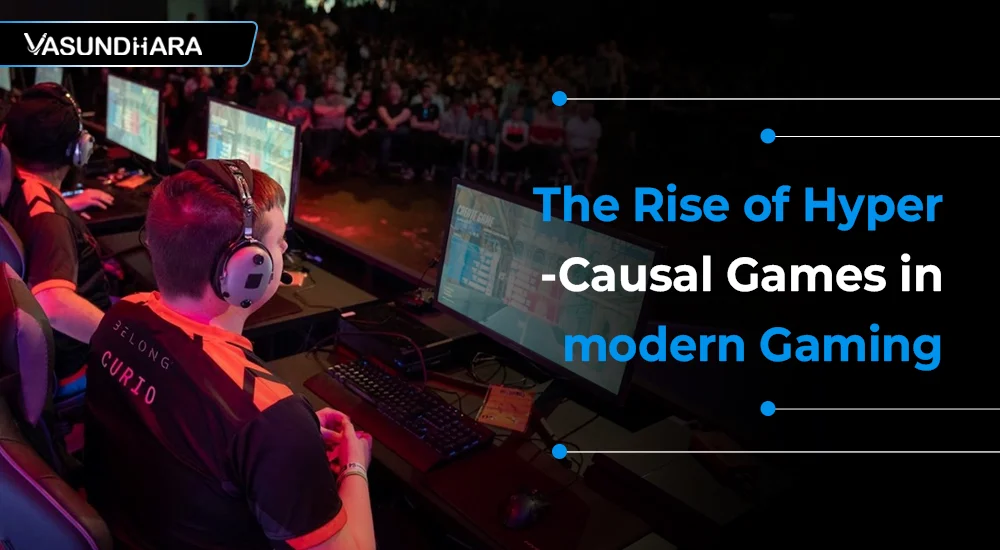The Rise of Hyper-Causal Games in modern Gaming


- Sep 13, 2023



Over the years, mobile gaming has experienced a remarkable shift.
We've progressed from simple, text-based games that formerly dominated the smartphone environment to highly sophisticated and visually gorgeous games just a few taps away.
However, a new type of game has arisen as a dominant force in this evolution: hyper-casual games.
This blog will look at the definition of hyper-casual games, the roots of hyper-casual games, the appeal of hyper-casual games, the business side of hyper-casual games, challenges in hyper-casual game space, and the future of hyper-casual games.
Hyper-casual games are characterized by simplicity, simple mechanics, and short playtime.
They are the antithesis of games that have traditionally defined the gaming landscape, characterized by their intricacy, length of play, and emphasis on graphic detail.
In contrast to other categories of mobile games, such as casual, mid-core, and hard-core games, hyper-casual games are intended to be playable by many people regardless of their previous experience with video games or their current gaming expertise.
The hyper casual games genre currently represents a significant segment of the market. Below are some of the important hyper-casual games statistics.
Approximately 50% of all games downloaded on mobile platforms are of this particular category, and it appears that their prevalence will continue to expand in the foreseeable future.
The global Hyper Casual game market size was valued at USD 1,560.0 million in 2021 and is projected to reach USD 2,470.0 million by 2027, expanding at a CAGR of 7.96% during the forecast period.
The share of gaming app installs for hyper casual games increased by up to 3.5 times in the past year.
Subway Surfers was the most downloaded free recreational gaming app globally in July 2023, with over 17 million downloads across Google Play and the Apple App Store.
The origins of hyper-casual games can be traced back to the early days of mobile gaming.
The titles "Snake" on early Nokia phones and "Tetris" on the Game Boy can be regarded as early pioneers within this genre.
These games were easy to play, addictive, and ideally suited for the early mobile devices' restrictions.
From these crude beginnings, hyper-casual games developed through time to become the contemporary hits we know today.
To produce incredibly engaging experiences, its gameplay mechanics and graphics were improved.
Why do hyper casual games appeal to such a large audience? There are numerous crucial factors:
Hyper-casual games offer instant gratification.
They can be picked up and played in a matter of seconds, making them ideal for filling brief gaps in our daily schedules, such as during a commute or a short break.
These games are designed to be appealing to both gamers and nongamers.
They are accessible to all age categories and demographics, from children to the elderly.
Hyper-casual games frequently employ in-game advertisements as their primary monetization strategy, allowing players to play for free.
Optional in-app purchases for customization or ad removal provide players with a means to support the developers and enhance their gaming experience.
Social media has played a crucial role in the meteoric ascent of certain hyper casual video games.
The "Flappy Bird" phenomenon, in which the game went viral via word of mouth and social sharing, exemplifies the effectiveness of virality in this genre.
A thoughtful approach to development and marketing is at the heart of every successful hyper-casual game.
Compared to more complicated titles, hyper-casual games frequently have cheaper development expenses.
Shorter development cycles result in faster time to market, allowing developers to experiment with different game concepts.
Developers use tactics to attract and maintain players. Key performance indicators (KPIs) such as Day 1 and Day 7 retention rates are regularly tracked to determine a game's success.
The rise of casual gaming publishers has become an essential ecosystem component.
Publishers collaborate closely with creators to improve games and test them extensively to uncover future hits.
Even though they are popular, some challenges are associated with hyper-casual games.
There are so many super-casual games out there that it can be challenging for new ones to stand out.
Developers must come up with new ways to get the attention of players.
Players usually move quickly from one casual game to the next.
Developers must add new content and exciting game features to keep players from leaving.
Finding the right mix between ads and user experience is essential for making money.
People might stop playing a game if it has too many ads, but ads are necessary for making money.
The future of hyper-casual games promises fresh developments that will engage players even more and improve the gaming experience.
Developers are thinking outside the box to create engaging, one-of-a-kind gameplay experiences.
Even on mobile devices, hyper-casual games will continue to improve with amazing graphics and flawless animations. Adding complex visual effects to games can make them more enticing and addictive.
Combining hyper-casual mechanics with elements from other genres, such as puzzle or strategy, can generate intriguing new gameplay dynamics.
Hyper-casual games will continue to adapt to shifting player expectations, technical breakthroughs, and societal trends in the future, providing diverse, entertaining, and accessible gaming experiences to a wide audience.
Developers that innovate and implement these trends are likely to prosper in this fast-paced environment.
Hyper-casual games may explore more immersive experiences as augmented reality (AR) and virtual reality (VR) technologies progress. Players can expect games that flawlessly integrate the virtual and real worlds.
Emerging technologies such as AR and VR have the potential to take hyper-casual games to the next level by providing immersive experiences that were previously impossible on mobile devices.
There has been an essential shift in the mobile gaming landscape brought on by the proliferation of hyper-casual games.
They have been propelled to the forefront of the market due to their straightforwardness, accessibility, and widespread popularity.
Unlock the world of hyper-casual game development with Vasundhara Infotech, a leading mobile game development company in India.
Our skilled team can turn your ideas into addictive mobile games. Harness our expertise to captivate players and achieve success.
From concept to launch, we're your partners in success. Don't miss out on the gaming revolution.
Contact us today and power up your game development journey!
Copyright © 2025 Vasundhara Infotech. All Rights Reserved.